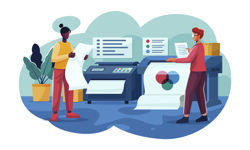Learning how to increase landing page conversion rates can mean the difference between success and failure for your entire internet marketing programme.
"Nothing happens until somebody sells something," has been a marketing mantra for decades. Today, it might better be stated, "Nothing happens until somebody writes an internet landing page." Landing pages are the driving force for any successful internet marketing programme.
While sales letter landing pages are the focus for many internet marketers, there are seven other types of landing pages. Optimising landing pages requires a solid knowledge of website architecture, webpage design, online copywriting and direct response testing.
‘Landing page’ is a relatively new direct marketing term for a familiar idea and an effective online sales campaign component.
But unlike traditional direct mail or retail marketing, where the user experience is more linear, every page on your website is a potential landing page. The user can enter your site and ‘land’ almost anywhere.
Landing pages are often sales letters, and their importance can't be over-emphasised. Imagine a world in which you could have dozens - or even hundreds - of energetic, absolutely reliable, sales reps who never sleep, who work 24/7, and who, given a predictable and steady level of traffic, will produce the same conversion rate, with the same number of sales, month after month. That's what effective sales letter landing pages can do.
A well-crafted landing page, with strong conversion architecture, will maximise the possibility that a user landing there will take the action you desire and not click away to some other site. Learning how to increase landing page conversion rates can mean the difference between success and failure for your entire internet marketing programme.
Eight Types of Landing Pages
Before creating landing pages, it’s best to know how to use them.
We define a landing page as any webpage where a publisher initiates an exchange of information with a willing user. This could be subscribing to an email newsletter, downloading a free report, registering for an event, filling out a survey, purchasing a book, or joining a membership organisation. Most landing pages evoke some response from the user.
Landing page internet marketing is a multi-sourced exercise, where many landing pages handle traffic from internet space ads, pay-per-click ads, co-registration, print ads, direct mail, public relations and other sources.
A landing page is also the place where, as publishers, we begin to track direct response transactions. It's where users enter our sphere of influence and we can ‘cookie’ them to see how they behave.
Many people think landing pages are exclusively online sales letters, but we have identified eight types and two classes of landing pages - organic and conversion.
Three Types of Organic Landing Pages
The strategic intent of an organic landing page is to attract users and convert them to customers. Publishers use organic landing pages when they can't control where the user is going to enter (or ‘land’ on) their website.
Organic landing pages are wide open and full of content that the publisher has designed to be attractive to users and search engines. Essentially, an organic landing page is trying to get a user searching with Google, Yahoo or MSN to find it.
Organic landing pages usually have substandard conversion architecture. The process of getting search engine spiders to find them, and other websites to link to them, requires them to be heavy with content and light on conversion architecture.
Optimally, organic landing pages attract targeted website traffic and convert visitors into subscribers, buyers or registered users. Organic landing pages are most often associated with search engine optimisation (SEO), ie. they are optimised for a specific keyword term or phrase.
An organic landing page needs to be designed to pull traffic in and initiate a transaction. To move the conversion process along, website designers insert such page elements as OFIEs (order forms in editorial); OFINs (order forms in navigation); floater order forms; display ads; text ads; and simple hypertext links.
The Mequoda research team has identified three types of organic landing pages, each with its own unique information architecture designed to pull traffic in and initiate a transaction.
An article landing page contains narrative content. They can be news stories, how-to articles or general information editorials of any kind. The objective of the article landing page is to capture the users’ interest in the editorial content and to lead them to a transaction.
A glossary landing page, as the name suggests, is a website with a glossary that lists dictionary-like definitions of words, phrases or concepts. Glossary landing pages attract traffic and include conversion architecture that urges users to subscribe or engage in some other transaction. Like the article landing page, the objective of the glossary landing page is to capture the users’ interest in the content and lead them to a transaction.
Directory landing pages include home pages, topic pages and category pages that list articles appearing on other web pages. Like glossary landing pages, directory landing pages are designed to attract traffic. They include conversion architecture that urges users to take the next step in the transactional process. At a minimum, such architecture usually includes order forms in editorial (OFIEs) or hypertext links to order forms.
Five Types of Conversion Landing Pages
Conversion landing pages are designed to receive targeted website traffic and convert users into buyers or subscribers. Conversion landing pages are sometimes designed to attract traffic, but are always designed to convert traffic.
Traffic generally arrives at conversion landing pages via links from sources the publisher controls, such as PPC (pay-per-click), affiliate marketing or paid advertising.
The sole strategic intent of a conversion landing page is to get an order. Therefore, the ecommerce conversion architecture for conversion landing pages is overt and aggressive. Website designers always use text links, order buttons and order forms to enable the user to initiate direct response transactions on conversion landing pages.
To date, our research team has identified five unique variations on the conversion landing page:
Rapid conversion landing pages are used to entice a user to enter into a low-risk (also known as a low-friction) transaction. Rapid conversion landing pages are used when there is no cost to the user (a free offer) or when payment is delayed or optional (a bill-me-later offer).
Rapid conversion landing pages always request an email address from the user to begin an online relationship and send additional offers. A rapid conversion landing page is sometimes referred to as a name squeeze page.
Sales letter landing pages resemble traditional direct response sales letters. They are used to maximise conversion rates for paid offers. These letters often do double duty and are reformatted for use in email and postal direct marketing programmes.
The up-sell landing page offers the user an additional product or service as part of the post-transaction process. Often, up-sell landing pages are ‘thank you’ pages that confirm a user's order for one product while simultaneously making a limited-time or reduced-price offer for a second product.
When properly executed, up-sell landing pages can be highly effective, delivering conversion rates as high as 20 to 30%, depending on the offer.
Access challenge landing pages prompt users for a password or require an email sign-up process. These are the landing pages that users encounter when trying to access premium (members-only) content from a site when they are not a member or not logged-in.
Access challenge landing pages aren't limited to paid membership websites. Sometimes an access challenge landing page is used only to request a user's name and email address. Like the rapid conversion landing page, this type of access challenge landing page is sometimes referred to as a name squeeze page.
The priority code landing page is a hybrid conversion landing page. A publisher might drive users to a priority code landing page where they can enter a proprietary combination of letters or numbers (alphanumeric code) in order to qualify for a special discount or express service.
Ads from external media generally drive users to priority code landing pages. Often, offers made in print, such as coupons in newsletters, magazines or other non-internet media employ individual priority codes to track response.
Conclusion
The ultimate goal of landing page driven internet marketing is to create a flow of website pages that maximise conversion and create the greatest number of sales.
The beauty of internet marketing is that it is much broader than direct mail marketing because there are so many sources of traffic. With effective landing pages, internet marketing can be the most reliable form of direct marketing ever created - more reliable that direct mail, or TV infomercials, or retail - because your message is spread out over numerous channels.
With internet marketing, you can use a combination of organic marketing, pay-per-click marketing, print advertising and affiliate marketing. They all run off landing pages. You can even take the landing page, convert it to an email message, and send it to your database.
If you approach your internet marketing system correctly, with well-crafted landing pages that use proven conversion architecture, you can have a very stable business.
That means running an effective programme, using a combination of organic and conversion landing pages that acquires leads, creates a database of email addresses and immediately up-sells users to paid products.
Such a system is not the easiest system to construct, but it is straightforward. Once it's built, it is reliable, stable and has predictable results.
FEATURE
Landing Page Driven Internet Marketing
The marketer’s lexicon has expanded dramatically in this online age. Terms and phrases unheard of even five years ago, are now commonplace in our marketing departments. One such ‘new’ term is ‘landing page’. Don Nicholas explains its significance and also introduces us to its many different forms.










